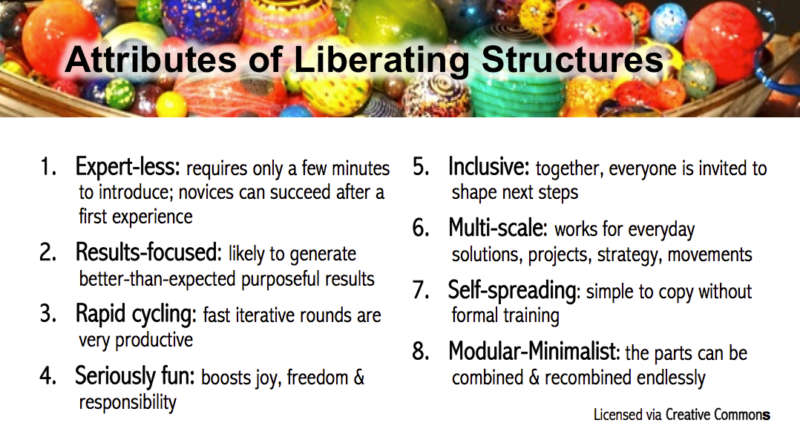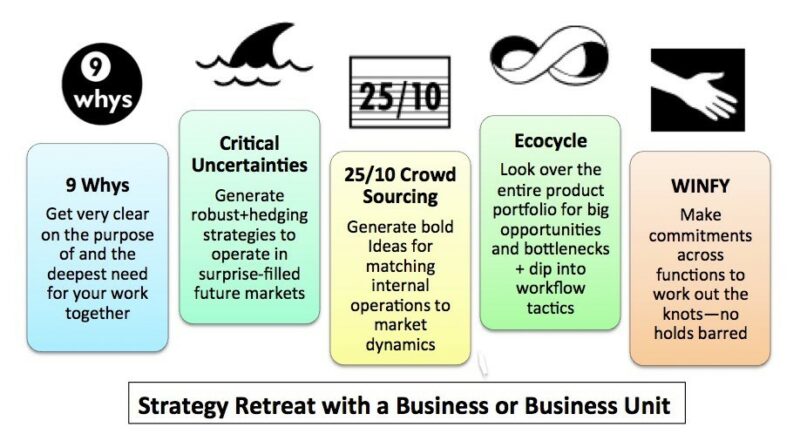What is a Liberating Structure?
Liberating [verb]: to set free from imposed, controlling structures
Structures [noun]: simple rules that specify how people are included and participate
Liberating Structures (LS) are simple rules that make it possible to include and engage every voice in the room when shaping the future. The LS repertoire consists of 33 practical methods versatile enough for anyone to use for a wide array of activities and challenges.
LS methods spark lively engagement by minimally structuring the way we interact while liberating content or subject matter. Very simple constraints unleash creative adaptability, generating better than expected results. Individual brilliance and collective wisdom are optimised. Many people think dramatic shifts cannot be that simple, engaging, and powerful but we’ve found this to be the common experience reported by LS users.

What sparked the development of Liberating Structures?
I started my career in healthcare with big ideas for changing the world. I studied management, leadership, health policy and strategy. However, my experience in organisations was filled with frustration. We never seemed to “get around to” the real work much less something strategic, even when I was the boss. I suspect many people have had similar experiences. Have you ever:
..tried earnestly to get everyone’s best thinking on a big problem only to hear the usual responses from the usual suspects while everyone else looked on with bored, cynical faces?
…been subjected to droning PPT presentations that exhort you to adopt practices imported from outside your organisation but are a poor fit for your local challenges?
… had a leader, with the goal of gaining consensus, open the discussion to all points of view, only to have an unproductive two-sided argument break out?
… walked into a meeting where a presentation was underway while the participants were checking e-mail on their computers and phones?
… worked in an organisation with troubling inconsistencies between what is said (the stated values) and what is done (the behaviours in practice)?
I felt there must be a better way to work together productively on these types of big challenges. Liberating Structures is both a response and an antidote to these unproductive patterns.
Complexity Science is a key foundation for Liberating Structures, but it can be quite, well – complex. How practical is the application of Liberating Structures on a wide spread basis?
Paradoxically, LS are easy to learn and applicable in diverse settings. LS users do not need to study complexity science to get results and none require expert training. Seeing them in action once is enough for many novices to get results and adapt them for use in other settings. LS are designed for everybody every day. Users apply LS to personal development, everyday meetings, projects, strategy-making and movements.
With more volatility, uncertainty, complexity and ambiguity (VUCA) in work life, a conventional approach to organising does not serve us well. A mechanistic-reductionist approach suggests we gain from: more controlling and predicting from the top; reducing work into smaller and smaller functional tasks; and, managing “human resources” as interchangeable parts. In contrast, LS focus on complex interactions among the parts, functions, and the operating environment. This better fits our VUCA world.
Additionally, LS are practical because the requirements for small-scale changes are similar to the requirements for systemic large-scale changes. The manager who wants to improve department performance, the teacher who wants to engage students, the community organiser who tries to give more of a voice to citizens, the IT professional who wants an effective Agile team, the doctor who wants to improve teamwork – all need methods that are simple, quickly learned, easy to use and versatile.

You developed Liberating Structures over a 12-year period – what were your key learnings during the evolution of the structures?
I’ve learned that including and unleashing more people productively solves a surprisingly large number of chronic problems. Unwittingly, conventional habits and practices we have inherited stifle good ideas and flatten our organisations (and ourselves). With a little courage and determination, it is possible to stop the unhelpful habits and start organising more productively. Making progress on serious challenges has never been so much fun!
Over a decade of development and in the LS community of users, we are searching for answers to this question:
If organisations are not machine-like but rather are complex adaptive systems (similar to ecosystems or living systems), how could managers and leaders and front line workers at all levels organise themselves to make decisions, address opportunities and problems, and shape the future together?
A hypothesis has taken shape, which is that in an ecosystem, all elements are connected, contribute and are interdependent. Therefore, it follows that methods developed to help organise a “complex living ecology” have to include and unleash everybody, every day. Not only the most privileged people for the special event, but also the least powerful in mundane every day interactions like meetings, patient rounds and classrooms activity. Hence the simplicity, inclusivity, and versatility of LS are “must do” or minimum specifications.
What would be your top 5 Liberating Structures to get people started?
My top 5 ‘getting started’ LS are 1-2-4-All, TRIZ, What3, 15% Solutions and Troika Consulting. Three more that must be mentioned in regard to health and care are 9 Whys, Wicked Questions and 25/10 Crowdsourcing. Q Community members on the workshop design team will be selecting and stringing together many of these LS.

Are there any specific case studies/success stories of the use of Liberating Structures in Healthcare that particularly stand out to you?
A good example is Superbug Prevention, Plus Enduring Cultural Change, a multisite action research study across Canada. This shows how LS can be used to solve a problem and forever change how people work together on challenges. Principle investigator Dr. Michael Gardam highlighted that they were able to generate scientific proof that social interventions work and change culture on the front line. The evaluation team dubbed the transformation as front line ownership or FLO.
Some other other good examples are, Getting OUT of the IN-formation IT Department; Marisa’s Rehearsal for Real Life as a Nurse; and, Leaving Sight of Land to Invent the Future of Health Care.
What would you like Q members to get out of the day at the Liberating Structures workshop?
I would like each person to have more energy, confidence, and momentum for positive change in their work.
I would like each and every Q member to find an LS or two or three they want to use for a challenge they face, and immediately put them into practice. LS help people act their way into new thinking.
Further, I would like each member to meet at least one other person to serve as a practice partner. Throughout the development of LS, Henri and I relied on each other to let go of old habits and bring in the new. Now, Fisher and I do the same thing. Find someone who will tell you the unvarnished truth!
Our top dream would be to see a few participants decide to form a user group to spread and deepen practice in their local community. Fisher and I would be happy to help.
The Q Liberating Structures workshop is now fully booked, but the team at LS will be hosting a two day immersion workshop in London with people from other domains like business, government, and philanthropy on 22-23 March.
Comments
Dominique 21 Feb 2018
Great summary thanks, looking forward to this session!!